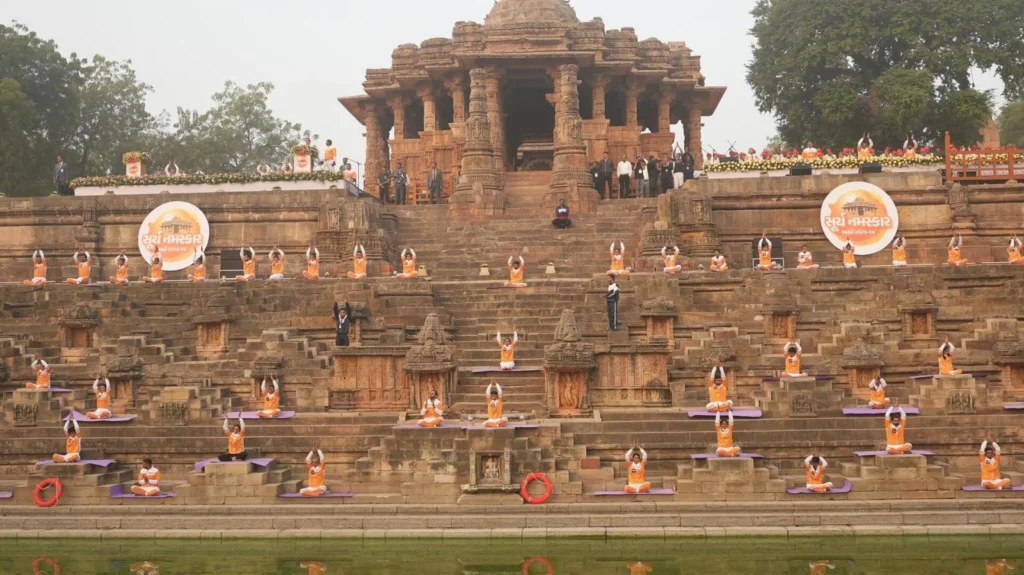Gujarat has achieved a Guinness World Record, as over 50,000 individuals across the state performed Surya Namaskar simultaneously at 108 venues.
- The statewide event was highlighted by the main gathering at the iconic Modhera Sun Temple in Mehsana district.
What is Surya Namaskar?
- Surya Namaskar, also known as Sun Salutation, is a traditional sequence of yoga asanas (poses) performed in a flowing sequence.
- It is a holistic practice that combines physical postures, breath control, and mindfulness.
- It is widely practised in various forms and styles of yoga and is considered a complete body workout.
- The word “Surya” means the sun, and “Namaskar” translates to salutation or greeting.
- The practice is a way of expressing gratitude and reverence to the sun, which is considered a symbol of life and energy in many cultures.
Basic outline of the Surya Namaskar sequence:
- Pranamasana (Prayer Pose): Stand at the edge of your mat, bring your palms together in front of your chest, and take a moment to centre yourself.
- Hasta Uttanasana (Raised Arms Pose): Inhale as you lift your arms overhead, extending your spine and reaching towards the sky.
- Hasta Padasana (Hand to Foot Pose): Exhale as you bend forward at the waist, bringing your hands to the floor beside your feet. Keep your spine straight.
- Ashwa Sanchalanasana (Equestrian Pose): Inhale and step your right leg back into a lunge position, with the left knee bent and hands on the mat.
- Dandasana (Plank Pose): Inhale and step your left leg back, bringing your body into a straight line from head to heels.
- Ashtanga Namaskara (Eight-Limbed Salutation): Lower your knees, chest, and chin to the mat while keeping your hips lifted. This pose involves touching the ground with eight body parts – the two hands, two feet, two knees, chest, and chin.
- Bhujangasana (Cobra Pose): Inhale and lift your chest, keeping your hands on the mat and elbows slightly bent.
- Parvatasana (Mountain Pose): Exhale and lift your hips towards the sky, forming an inverted V shape with your body.
- Ashwa Sanchalanasana (Equestrian Pose): Inhale and step your right foot forward between your hands, returning to the lunge position.
- Hasta Padasana (Hand to Foot Pose): Exhale and bring your left foot forward to meet your right, bending at the waist with your hands on the mat.
- Hasta Uttanasana (Raised Arms Pose): Inhale and rise up, extending your arms overhead.
- Pranamasana (Prayer Pose): Exhale and return to the starting position with palms together in front of your chest.
About Modhera Sun Temple:
- The Modhera Sun Temple is an ancient Hindu temple dedicated to the solar deity Surya.
- It is located in Modhera, a small village in the Mehsana district of Gujarat, India.
- The temple is renowned for its exquisite architecture and intricate carvings, representing one of the finest examples of Solanki or Maru-Gurjara architecture.
Key features of the Modhera Sun Temple:
- Construction: The temple was built in 1026-27 CE during the reign of King Bhimdev I of the Solanki dynasty.
- It is said to be designed by the renowned architect from Sompura, which was known for its skilled craftsmen.
- Architecture: The temple is designed in a way that it faces east, ensuring that the first rays of the sun illuminate the sanctum at dawn during the equinoxes.
- The structure consists of a sanctum, a hall, and a tank (Surya Kund) in the front.
- The intricate carvings on the walls depict various scenes from Hindu mythology and showcase the skills of the craftsmen of that era.
- Surya Kund: The temple is accompanied by a large rectangular tank called the Surya Kund or Ramakund.
- This stepped tank is designed with numerous small shrines and carved panels.
- Devotees believe that taking a dip in the holy waters of the Surya Kund purifies them.
- Sabha Mandap (Assembly Hall): The assembly hall, known as Sabha Mandap, is an open hall with intricately carved pillars.
- The hall was likely used for religious gatherings, cultural events, and dance performances.
- Destroyed and Rebuilt: Like many historical structures, the Modhera Sun Temple faced destruction over the centuries.
- It was partially ruined by Mahmud of Ghazni in the 11th century.
- However, the temple remains a significant archaeological site, and efforts have been made to preserve and restore its remaining structures.
- Heritage Site: The Modhera Sun Temple is a protected monument under the Archaeological Survey of India (ASI) and is considered a national heritage site.
Ref: Source
| UPSC IAS Preparation Resources | |
| Current Affairs Analysis | Topperspedia |
| GS Shots | Simply Explained |
| Daily Flash Cards | Daily Quiz |




